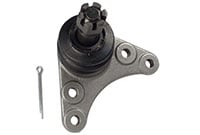Learn About Car Spindles to Ensure Chrysler Tie Rod End Safety
For a smooth and reliable ride, it’s important to know the key parts of your vehicle. Tie rod ends and car spindles are crucial for your car’s suspension and steering. At Great Auto Parts, we specialize in high-quality tie rod ends for Chrysler, offering you top performance and long-lasting durability.
Tie Rod Ends and Car Spindles: A Vital Connection for Your Vehicle
The connection between tie rod ends and car spindles is fundamental to your vehicle’s steering mechanism. The tie rod end links the steering rack to the steering knuckle, while the spindle acts as a pivot point for the wheel. Together, they ensure precise steering and stability, crucial for safe driving.
Differences Between Tie Rod Ends and Car Spindles
While both tie rod ends and car spindles are essential for your vehicle’s operation, they serve different functions. The tie rod end is responsible for transmitting steering force from the steering rack to the wheels, ensuring they turn in the desired direction. In contrast, the car spindle supports the wheel hub and bearing assembly, allowing the wheel to rotate smoothly.
Functions of Car Spindles and Tie Rod Ends in Your Vehicle
Car Spindle Functions
• Supports Wheel Rotation: Acts as a pivot for the wheel hub.
• Connects to Suspension: Integral part of the suspension system.
• Holds Brake Components: Mounts the brake caliper and disc.
Tie Rod End Functions
• Steering Precision: Transfers motion from the steering rack to the wheels.
• Alignment Maintenance: Keeps wheels aligned for smooth driving.
• Vibration Reduction: Minimizes steering vibrations for better control.
Visualizing the Tie Rod End and Car Spindle
Tie rod ends typically have a ball joint on one end that connects to the steering knuckle and a threaded section on the other end for adjustment. Car spindles, on the other hand, are solid metal parts with a mounting point for the wheel hub and bearings.
Locating the Tie Rod and Car Spindle in Your Vehicle
| Component Name | Function | Installation Location | Interaction |
| Tie Rod End | Connects the steering rack to the wheels, transmitting steering force and maintaining wheel alignment. | At the end of the steering system, connecting to the wheels | Transmits steering inputs to the Car Spindle, turning the wheels. |
| Car Spindle | Supports the wheels and allows them to rotate, also part of the suspension system. | In the suspension system, connecting to the wheels | Receives steering inputs from the Tie Rod End, facilitating wheel rotation and vehicle stability. |
Recognizing When Your Tie Rod End Needs Replacement
Common signs of a failing tie rod end include uneven tire wear, loose or shaky steering, and unusual noises when turning. Addressing these issues promptly can prevent further damage and ensure safe driving.
Regular Maintenance for Spindles and Tie Rod Ends
It’s important to check your tie rod ends and spindles regularly for wear and tear. As part of routine maintenance, inspect these components every 12,000 to 15,000 miles.
Impact of Tie Rod End Damage on Car Spindles
A damaged tie rod end can lead to misalignment, which puts additional stress on the car spindle. This can cause premature wear and impact the overall handling of your vehicle.
Risks of Neglecting Tie Rod End Maintenance
Ignoring tie rod end maintenance can result in steering failure, uneven tire wear, and potentially dangerous driving conditions. Regular inspections and timely replacements are crucial for maintaining vehicle safety.
Diagnosing Issues with Spindles and Tie Rod Ends
To diagnose issues, start with a visual inspection for signs of wear or damage. Listen for unusual noises during steering and check for uneven tire wear. Professional alignment checks can also reveal hidden problems.
Preventing Premature Wear of Tie Rod Ends Due to Spindle Problems
Problems with the car spindle can lead to premature wear of tie rod ends. Ensuring both components are in good condition is key to maintaining your vehicle’s performance and safety.
Steps to Inspect and Replace Tie Rod Ends During Suspension Overhaul
- Lift the Vehicle: Use a jack to lift the vehicle and secure it on stands.
- Remove the Wheel: Take off the wheel to access the tie rod end.
- Inspect the Tie Rod End: Check for signs of wear or damage.
- Remove the Old Tie Rod End: Use a wrench to loosen and remove the tie rod end.
- Install the New Tie Rod End: Attach the new tie rod end and tighten it to the manufacturer’s specifications.
- Reassemble and Test: Reinstall the wheel, lower the vehicle, and test the steering for proper function.
Impact of Materials on Tie Rod End Durability and Performance
The materials used in tie rod ends significantly affect their durability and performance. High-strength steel and advanced surface treatments ensure long-lasting, reliable tie rod ends.
Features of Great Auto Part' Tie Rod Ends
- OEM Quality: Developed from OEM samples for perfect fit.
- High-Strength Steel: Made with cold forged or hot forged steel.
- Anti-Rust Protection: Surface treatment for best anti-rust protection.
- Tracking Codes: Laser-etched batch codes for quality tracking.
- Strength Tested: Pull or push out strength equal to or higher than OE.
- Direct OE Replacement: No fitting issues for seamless installation.
- Small Quantities Accepted: MOQ as low as 30 pieces.
Opting for top-notch tie rod ends and understanding how they work with car spindles is essential for keeping your vehicle safe and running smoothly. At Great Auto Parts, we provide Chrysler tie rod ends that go beyond OEM standards, giving you reliability and long-lasting performance. Regular check-ups and timely replacements can help you avoid expensive repairs and keep your car in peak condition. Reach out to us today to find out more about our products and how we can assist with your vehicle maintenance needs.






